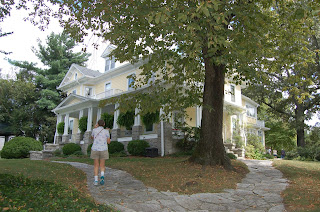The past week was spent visiting with long time friends Wayne and Denise. I worked with Wayne for 25 years in Dayton, Ohio. We had a great time reconnecting with them. We camped at Sawnee COE park on Lake Sidney Lanier. As usual I forgot to take pictures of our camp site. This is a nice Corp small campground with about 50 sites in it. Through the week it was very peaceful. Like most Corp parks in was busy with a lot of kids running around on the weekend. The sites are large with a nice picnic table areas at each site. We walked around the park picking out the site we would like when we return to this area.
This water tower picture was taken along the route to Georgia. We thought it was funny that it was in South Carolina when Georgia is the peach state. It was one of the coolest water towers we have ever seen.
We arrived at the park on Monday the 14th. Wayne and Denise came over to pick us up for trip to the Texas Roadhouse for supper. We had great time catching up to the present and reminiscing about old times.
Wednesday we headed to Dahlonega, Ga for a walk around town. Dahlonega is know as the site of the first gold rush in the U.S. It is now a quaint little tourist town with a lot of shops to browse through.
There were a lot of scare crows around town.
We had a great time sightseeing the town.
The next day we went to go to Stone Mountain. Stone Mountain has been in the news lately because of the subject matter. It is a monument to the Confederate Generals Lee, Jefferson Davis and Stonewall Jackson. There is a group of people that want this removed from the mountain because of its ties to the Civil War and slavery. This is a great work of art and a part of history. We think that any move to remove this would be a travesty and a great loss to our history. If we destroy everything that may or may not be politically correct from our society we would have nothing left to view.
Stone Mountain is a quartz monzonite dome monadnock and the site of Stone Mountain Park in Stone Mountain, Georgia. At its summit, the elevation is 1,686 feet (514 m) MSL and 825 feet (251 m) above the surrounding area. Stone Mountain is well-known not only for its geology, but also for the enormous bas-relief on its north face, the largest bas-relief in the world.[1] The carving depicts three Confederate figures during the Civil War: Stonewall Jackson, Robert E. Lee, and Jefferson Davis.
This time of year none of the shops or rides in the park were open. This suited us just fine. For the $15.oo parking fee it allowed us to see the monument and walk around the grounds which was what we wanted to do anyway. On the weekend it would have cost us $29.00 each to get in.
To give you some perspective, the central figure (Lee) is one city block long!
Duane and Louise
Wayne and Denise
Wayne and I both ride motorcycles. On Saturday we mounted our bikes for a 150 mile ride to the Wheels Through Time motorcycle museum. This is the premier American made motorcycle museum in the country.
There are hundreds of bikes on display from the very earliest to custom built choppers.
I loved this paint job.
The owner starts some of the bikes and rides them around the museum all day long. Most of the bikes on display actually run.
We had a great time on the ride and during our visit to the museum. They are adding bikes to this museum all the time, so a return visit is likely.
Sunday night was euchre night. When we all lived in Ohio we were members of a euchre club. For those that don't know, euchre is a midwest card game. In our travels we have discovered that if you are not from Ohio or Michigan, you have probably never heard of it. Louise and I won the best out five games so we decide it was a great time to leave while we were ahead.
We had a wonderful time visiting and sight seeing. Thank you Wayne and Denise for you hospitality.
Monday was a travel day. We are now in Valdosta , Ga for a visit with another long time friend and coworker from my GM days .
Til next time
Duane and Louise























































